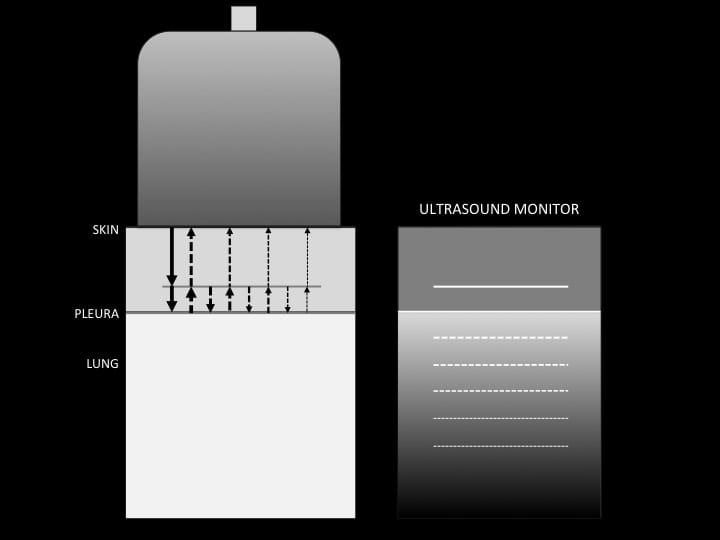Long path reverberation artefact
**A-lines = Long path reverberation artefact
Reverberation Artefact Refresh
An ultrasound machine assumes a single pulse of ultrasound enters the tissues, is reflected off a structure, and returns directly to the transducer for interpretation. When this does not occur ultrasound artefacts are created.
Not infrequently an ultrasound pulse encounters two parallel reflective surfaces lying perpendicular to its path. Some of the pulse becomes caught between the two surfaces, bouncing forwards and backwards before returning in increments, between each reverberation, to the transducer. This reverberation causes a repetitive artefact on the ultrasound image.
The appearance of the reverberation artefact depends on:
- The size of the two reflective surfaces
- The distance between the two reflective surfaces (long vs short path reverberation artefacts)
- And how much ultrasound energy is lost – dissipated or attenuated, between each re-reflection.
Long path reverberation artefact
When appearing deep to the pleural line these are known as A-lines.
The ultrasound appearance of this artefact is repetitive, horizontal, echogenic lines deep to the second of two large reflective surfaces, between which the ultrasound energy is reverberating. Most commonly this artefact appears deep to a flat surface behind which is an gas collection, typically a pneumothorax, free gas in the abdomen, or gas within a loop of bowel.
How long path reverberation artefact is formed (A-lines)
The ultrasound beam hits the highly reflective pleural surface and is reflected back to the transducer. The first return results in a true image of the pleural surface on the monitor. The beam however reflects back again off the transducer face and the cycle repeats.
Subsequent horizontal lines are weaker and are artefacts. Their clarity depends on how good a reflective surface is encountered by the ultrasound beam.

A-lines – Pneumothorax and Lung Point
The ultrasound clip shows a lung point. The first bright horizontal line is the pleural surface with sliding lung on the left and pneumothorax on the right. The bright horizontal lines deep to the pleura are long path reverberation artefacts (or A-lines as they are known in the chest).
Alternate mechanism of long path reverberation artefact formation
Here reverberation occurs between two closer horizontal lines; a fascial plane and the pleural surface. Recurrent horizontal artifactual lines are therefore closer together.

Another example of A-lines
This is a pneumothorax. The pleural line can be seen horizontally just deep to the two ribs which are in cross section. The repetitive horizontal lines deep to this are caused by ultrasound reverberating between the facial planes and the pleural surface.
Long path reverberation artefact in bowel
These long path reverberation artefacts originate from gas within the bowel, and peristalsis can be seen. Reverberation is between the abdominal parietal peritoneum and gas within the bowel lumen.
Long path reverberation artefacts: Summary
Further Reading
- Long path reverberation artefact (A-lines in lung)
- Short path reverberation artefact (B-lines in lung; ringdown anywhere else!)
- Fatiguing short path reverberation artefact (Comet tails)
- Fatiguing short path reverberation artefacts (Comet tails)
ULTRASOUND LIBRARY
Basics
An Emergency physician based in Perth, Western Australia. Professionally my passion lies in integrating advanced diagnostic and procedural ultrasound into clinical assessment and management of the undifferentiated patient. Sharing hard fought knowledge with innovative educational techniques to ensure knowledge translation and dissemination is my goal. Family, wild coastlines, native forests, and tinkering in the shed fills the rest of my contented time. | SonoCPD | Ultrasound library | Top 100 | @thesonocave |

